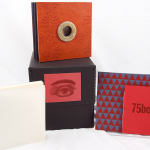Emily Larned
Seeing Trilogy, 2000
(Brooklyn, N.Y.): Red Charming
One of 25 copies, signed by Larned.
565
Further images
Four volumes, with the first 16-page booklet acting as an introduction to foundational ideas of camera and vision underpinning Larned's multi-form production. Among those cited are Annie Dillard, John Berger,...
Four volumes, with the first 16-page booklet acting as an introduction to foundational ideas of camera and vision underpinning Larned's multi-form production. Among those cited are Annie Dillard, John Berger, Oliver Sacks, and, of course, Roland Barthes and his ubiquitous Camera Lucida. The subsequent materials of Larned's trilogy challenge what the reader might assume about the operations of sight. The first entry, (8)ff. in translucent wrappers, bears text printed blind on white paper, so that the reader must not only see but feel. The second, 13 accordion-folded leaves with 4 tissue inserts in textured, patterned card wrappers, presents a series of illustrations that engage the reader in the visual distortions embedded in angles of perception and in the practice of memory. Barthes's influence is here at its most obvious. In Camera Lucida, Barthes draws heavily from Marcel Proust's In Search of Lost Time, using as an example Proust's narration of seeing his grandmother through a window while she is unaware of his presence. Confronted with this new, strange vision of someone otherwise familiar throws into stark relief the lapses inherent in sight. The trilogy's final component is a 7-panel tunnel book with cards as barriers between panels. Here the differences between reading and viewing nearly vanish, and the eye is more attuned than ever to its affinities with the camera. The materials together form an interactive approach to the theories of visual sensation in the machine age. All objects fine, housed in archival box.

















